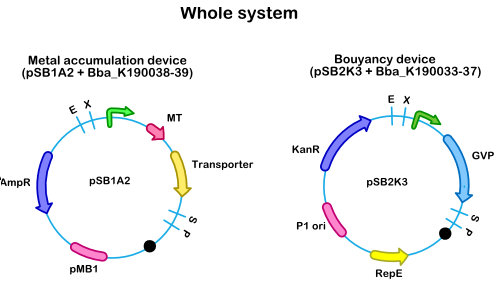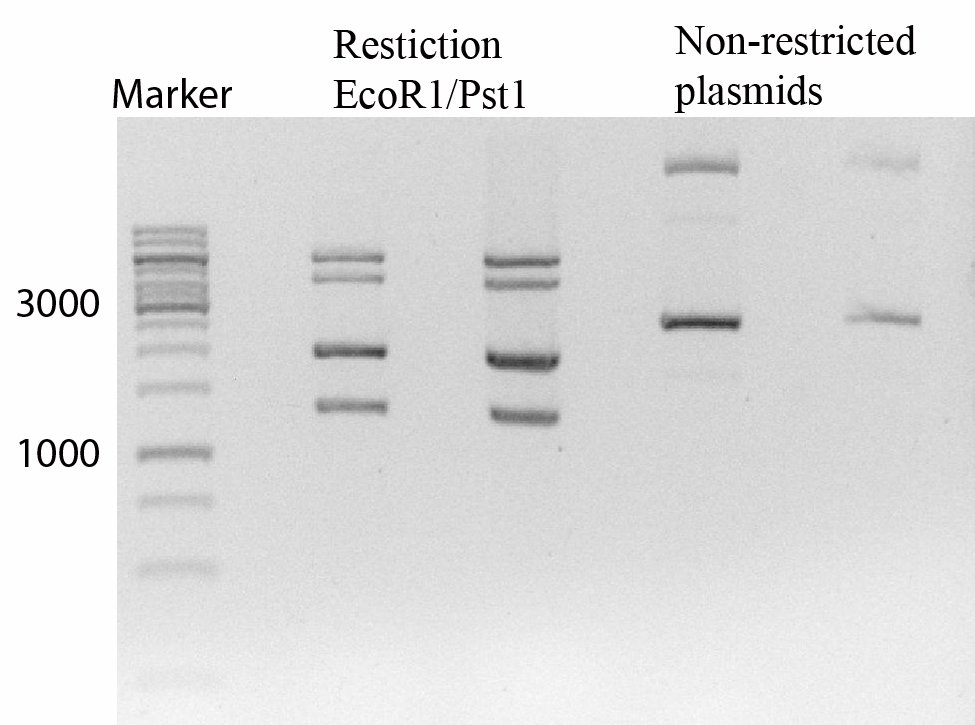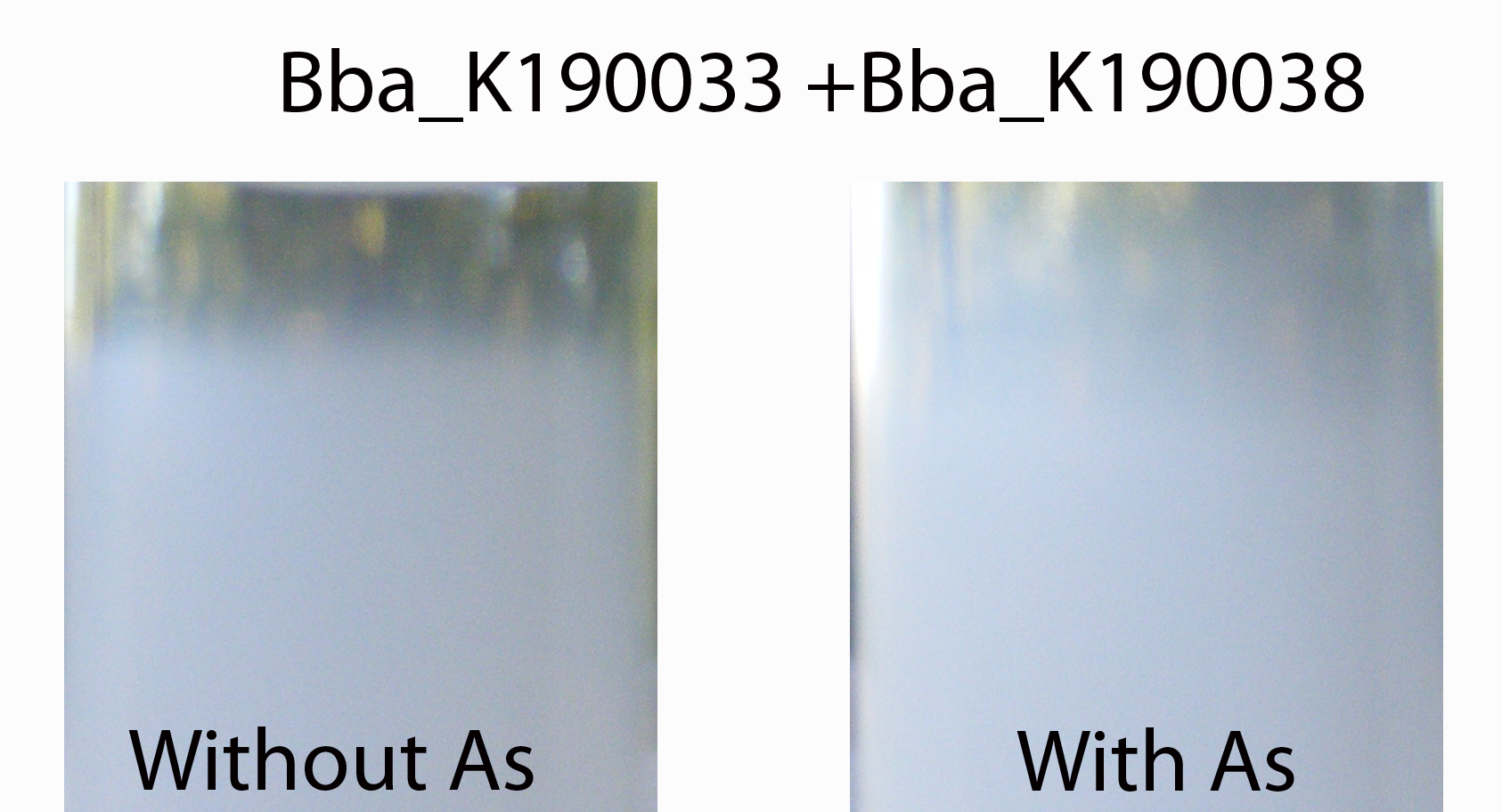Team:Groningen/Project/WholeSystem
From 2009.igem.org
(→Cloning Strategy) |
(→Results) |
||
| Line 18: | Line 18: | ||
====Restriction==== | ====Restriction==== | ||
| - | Figure | + | Figure 2 shows that the transformation of both vectors succeeded. |
[[Image: Groningen_GelPhotoSystemRestriction.png|400px]] | [[Image: Groningen_GelPhotoSystemRestriction.png|400px]] | ||
| - | + | :Figure 2:Gel image of restricted and not restricted plasmids. | |
| Line 32: | Line 32: | ||
[[Image:Groningen_SystemBouyancy33en38.png|400px]] | [[Image:Groningen_SystemBouyancy33en38.png|400px]] | ||
| - | '' | + | :Figure 3: Result of the buoyancy test, the left shows ''E.coli'' cells without arsenic induction and to the right floating ''E.coli'' cells, induced with arsenic, are shown. |
Revision as of 11:39, 17 October 2009
[http://2009.igem.org/Team:Groningen http://2009.igem.org/wiki/images/f/f1/Igemhomelogo.png]
|
|---|
Introduction
The metal scavenger with a vertical gas drive is a modular system which contains five modules; the transporter, an accumulation protein, a regulated promoter, a regulator and the gas vesicle cluster. The transporter imports the metal ion of choice. An accumulation protein facilitates accumulation of metal ions and prevents the cell from dying of the metal toxicity. The imported metal ion also acts as a regulator for the metal sensitive promotor which activates the expression of the gvp-cluster. Thereby the recombinant bacterium, with this system, accumulates metal and upon accumulation starts to float which is convenient in bioremediation or mining applications. The system explored in this project was based on arsenic. This metal is very toxic and causes health problems all over the world. The transported used here is GlpF () a glycerol transported known to import arsenic as well (Meng, YL, et al.2004), (Rosen, BR, et al.2009). Two accumulation proteins were chosen to accumulate arsenic, the fusion protein MBPArsR () and fMT (). Both accumulation proteins were combined with GlpF to create new accumulation devices (, ). As metal sensitive promotor, pArsR was chosen and together with the gvp cluster made a part . The two devices, the accumulation device and the buoyancy device were transformed together in E. coli, to create the metal scavenger with a vertical gas drive.
Cloning Strategy
In order to use the buoyancy device() in combination with the accumulation device (, ) a two vector system was used (see Figure 1). A two vector system was chosen because it is not feasible to combine the 6kb gas vesicle cluster, with a 1kb transporter and 300bp metallothionein and their promoters in one vector. This could easily increase the size of a vector to 10kb, a vector size which can hardly be transformed to E. coli. This two vector system is composed of a vector with the accumulation device(, ) and a vector with the buoyancy device (). This combination was choosen because it is possible to tranform both in one E.coli cell since the vectors contain different origin of replication,respectively a pMB1 origin of replication and a P1 ori and also contain different antibiotic resistance markers.
- Figure 1: Whole system, combining the bouyancy device on a pSB2K3 vector and the accumulation device on a pSB1AC3 vector
Results
Combining parts and was done by using a normal transformation protocol with both ampicillin and kanamycin as antibiotics. A buoyancy test was performed as described also using both ampicillin and kanmycin as antibiotics. Iptg was also added to the dayculture to induce the part. In exponential phase 10μM NaAsO2 was added to half of the samples. A restriction was done to check the transformation.
Restriction
Figure 2 shows that the transformation of both vectors succeeded.
- Figure 2:Gel image of restricted and not restricted plasmids.
The gel shows a 1Kb marker to the far left, after that two times a restriction with EcoRI and PstI can be seen. This shows clearly fragments of 6000pb and 4500pb for the and fragments of 2000pb and 1300 bp for the . The next two slots show non-restricted plasmids, two distinc bands can be seen clearly indicating the presence of two plasmids.
Buoyancy test
The buoyancy test elegantly shows that combining both an accumulation device and the gvp-buoyancy device allows buoyancy.
- Figure 3: Result of the buoyancy test, the left shows E.coli cells without arsenic induction and to the right floating E.coli cells, induced with arsenic, are shown.
On the left E. coli cells (containing the whole system) without arsenic can be seen and on the right E. coli cells (containing the whole system) with arsenic is shown. It can be seen that the right sample floats. This indicates that the GlpF is transporting the arsenic inside the cells, the fMT accumulates it (otherwise the cells would be dead) and the gvp was induced by the arsenic so the cells start to float.
 "
"









